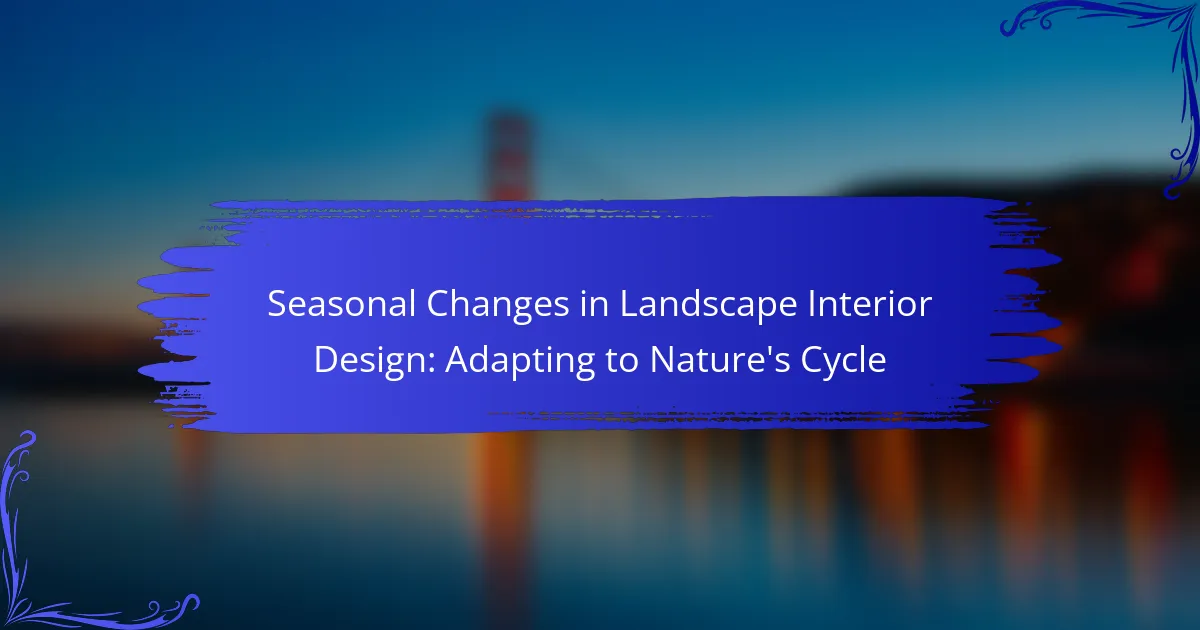Seasonal changes in landscape interior design involve the adaptation of design elements to align with different seasons, enhancing both aesthetic appeal and functionality in indoor spaces. Key seasonal adjustments include incorporating vibrant flowers and greenery in spring, using lighter fabrics in summer, introducing warm colors and cozy textiles in autumn, and focusing on rich materials and lighting in winter. Emerging trends such as biophilic design, sustainable materials, and adaptable spaces are increasingly utilized to create environments that reflect nature’s cycles. Research indicates that these seasonal modifications can improve well-being and user satisfaction by fostering a connection to nature. The article will explore these concepts and their impact on interior design practices.

What are Seasonal Changes in Landscape Interior Design?
Seasonal changes in landscape interior design refer to the adaptations made in design elements according to different seasons. These changes enhance the aesthetic appeal and functionality of indoor spaces. For example, in spring, designers may incorporate vibrant flowers and fresh greenery. In summer, lighter fabrics and open spaces promote air circulation. Autumn often brings warm colors and cozy textiles, while winter focuses on creating warmth with rich materials and lighting. These seasonal adjustments reflect nature’s cycles and influence mood and atmosphere. Research shows that seasonal design can improve well-being and comfort in living environments.
How do seasonal changes influence landscape interior design choices?
Seasonal changes significantly influence landscape interior design choices. Designers often adapt color palettes to reflect seasonal tones. For instance, warm hues are favored in autumn, while cool shades are preferred in winter. Plant selection also varies; seasonal blooms enhance indoor landscapes. In spring, vibrant flowers are popular, while evergreen plants maintain aesthetics in winter. Textures and materials are chosen based on seasonal themes. Soft fabrics are common in colder months, while lightweight materials are used in warmer seasons. Seasonal accessories, such as decor and lighting, are frequently updated to maintain relevance. This approach ensures that interiors harmonize with the natural environment throughout the year.
What are the key elements affected by seasonal changes?
Key elements affected by seasonal changes include temperature, daylight, precipitation, and plant growth. Temperature fluctuations influence the types of plants that can thrive in specific seasons. Daylight duration affects photosynthesis rates, impacting plant health and growth cycles. Precipitation patterns determine soil moisture levels, which are crucial for plant survival. Additionally, seasonal changes can alter wildlife behavior and migration patterns. These elements are interconnected and significantly impact landscape design choices throughout the year.
How do different seasons impact color schemes and materials?
Different seasons significantly impact color schemes and materials used in design. Spring often brings pastel colors and lightweight fabrics. These choices reflect the renewal of nature. Summer favors bright, vibrant hues and breathable materials. This aligns with the warmth and energy of the season. Autumn introduces earthy tones and textured materials. These selections mirror the changing foliage. Winter typically emphasizes cool colors and heavier fabrics. This reflects the cold and cozy atmosphere of the season. Seasonal trends influence consumer preferences in design. Designers adapt to these shifts to create appealing environments.
Why is it important to adapt landscape interior design to nature’s cycles?
Adapting landscape interior design to nature’s cycles is important for sustainability and ecological harmony. This approach enhances the aesthetic appeal by aligning design elements with seasonal changes. For instance, using plants that thrive in specific seasons ensures vibrant colors and textures year-round. Additionally, it promotes biodiversity by supporting local ecosystems. Research indicates that designs incorporating native plants can reduce water usage by up to 50%. Aligning with natural cycles also improves the well-being of inhabitants, as studies show that exposure to natural elements can reduce stress and enhance mood. Overall, this adaptation creates a more functional, beautiful, and sustainable environment.
What benefits does seasonal adaptation bring to interior spaces?
Seasonal adaptation brings several benefits to interior spaces. It enhances aesthetic appeal by allowing for seasonal decor changes. This practice can improve mood and well-being by aligning the environment with natural cycles. Seasonal adaptation also promotes energy efficiency by optimizing natural light and temperature control. For instance, using lighter fabrics in summer can reduce the need for artificial cooling. Additionally, it encourages sustainability by utilizing locally sourced materials that reflect seasonal availability. Research from the American Society of Interior Designers indicates that environments reflecting seasonal changes can increase occupant satisfaction by up to 30%. Overall, seasonal adaptation fosters a harmonious relationship between interior spaces and the changing environment.
How does adapting to seasonal changes enhance aesthetic appeal?
Adapting to seasonal changes enhances aesthetic appeal by creating dynamic visual experiences. Seasonal variations introduce diverse colors, textures, and forms into landscapes. For instance, spring blooms bring vibrant hues, while autumn foliage offers warm tones. These changes stimulate interest and engagement in outdoor spaces. Moreover, incorporating seasonal elements aligns designs with nature’s rhythm. This approach fosters a sense of harmony and balance in the environment. Studies show that environments reflecting seasonal changes positively impact mood and well-being. Engaging with nature’s cycles can also promote sustainability in design practices.

How can designers effectively incorporate seasonal changes?
Designers can effectively incorporate seasonal changes by utilizing adaptable materials and color palettes. They should select plants that thrive in specific seasons, ensuring year-round vibrancy. Seasonal decor elements can be rotated to reflect the changing environment. Designers can also create layouts that allow for natural light variations throughout the year. Incorporating textures that resonate with seasonal themes enhances the overall aesthetic. Research indicates that environments reflecting seasonal changes improve user satisfaction and engagement. Seasonal adjustments in design foster a connection to nature and promote well-being.
What strategies can be employed for seasonal adaptation in design?
Seasonal adaptation in design can be achieved through various strategies. Incorporating flexible layouts allows spaces to be reconfigured according to seasonal needs. Utilizing seasonal materials enhances the aesthetic relevance of the design. Integrating natural elements, such as plants, can create a connection to the changing environment. Implementing color schemes that reflect seasonal palettes helps to evoke the desired atmosphere. Utilizing energy-efficient lighting can adjust to seasonal daylight variations. Designing for climate responsiveness ensures comfort throughout the year. Lastly, incorporating technology for smart home systems can optimize environmental control as seasons change. These strategies collectively enhance the functionality and appeal of design throughout the year.
How can natural elements be integrated into interior design?
Natural elements can be integrated into interior design through various methods. Incorporating plants is a common approach. They improve air quality and add color. Using natural materials like wood and stone creates a warm atmosphere. Large windows can bring in natural light and views of the outdoors. Earthy color palettes mimic natural landscapes. Textiles made from organic fibers enhance comfort and sustainability. Water features can introduce tranquility and sound. Biophilic design principles focus on connecting occupants with nature. These strategies create a harmonious and inviting space.
What role do plants and seasonal flowers play in design adaptation?
Plants and seasonal flowers are essential in design adaptation as they enhance aesthetic appeal and harmonize spaces with nature. They provide visual interest and color variations throughout different seasons. This adaptability allows designers to create dynamic environments that reflect the changing landscape. Seasonal flowers can evoke specific moods and themes, contributing to the overall ambiance. Incorporating plants also improves air quality and promotes well-being. Studies show that greenery can reduce stress levels and increase productivity in interior spaces. Thus, using plants and seasonal flowers is a strategic approach to align design with natural cycles.
What are the challenges of seasonal changes in landscape interior design?
Seasonal changes in landscape interior design present several challenges. One significant challenge is the need for continuous adaptation to varying weather conditions. Different seasons require distinct materials and plants to thrive. For instance, winter may necessitate the use of evergreen plants, while summer might favor vibrant flowering species.
Another challenge is maintaining aesthetic appeal throughout the year. Designers must plan for seasonal transitions to ensure visual continuity. This often involves strategic planting and design choices that accommodate seasonal blooms and foliage changes.
Budget constraints can also pose difficulties. Seasonal changes may require additional investments in materials and labor for redesigns. This can strain budgets, especially for clients seeking year-round beauty.
Lastly, environmental factors such as climate change can complicate design efforts. Designers must consider the impact of unpredictable weather patterns on plant health and landscape integrity. Overall, these challenges require careful planning and foresight in landscape interior design.
How can designers overcome seasonal limitations?
Designers can overcome seasonal limitations by utilizing versatile materials and adaptable designs. They can select plants that thrive in varying conditions, ensuring year-round appeal. Incorporating indoor elements allows for continuity regardless of outdoor changes. Seasonal themes can also be integrated into design, allowing for easy updates. Utilizing technology, such as automated irrigation, helps maintain plant health in fluctuating climates. Additionally, designers can create flexible spaces that accommodate different seasonal activities. Research indicates that adaptable designs enhance user experience throughout the year. For instance, studies show that biophilic design improves well-being across seasons.
What are common pitfalls to avoid when adapting to seasonal changes?
Common pitfalls to avoid when adapting to seasonal changes include neglecting plant selection. Choosing plants unsuitable for the climate can lead to poor growth. Overlooking maintenance schedules is another issue. Seasonal changes require different care routines, such as watering and pruning. Failing to consider seasonal color palettes can result in a disjointed aesthetic. Each season offers unique color opportunities that should be embraced. Ignoring local climate patterns can lead to mismanagement of resources. Understanding regional weather trends is essential for effective adaptation. Lastly, not incorporating flexible design elements can limit future adjustments. Designs should be versatile to accommodate changing seasons effectively.

What specific trends are emerging in seasonal landscape interior design?
Emerging trends in seasonal landscape interior design include biophilic design, sustainable materials, and adaptable spaces. Biophilic design integrates natural elements into interiors, enhancing well-being. This trend reflects a growing awareness of nature’s positive impact on mental health. Sustainable materials prioritize eco-friendly options, reducing environmental impact. Designers increasingly use reclaimed wood, bamboo, and recycled materials. Adaptable spaces allow for seasonal changes, such as movable furniture and modular designs. This flexibility caters to varying needs throughout the year. Additionally, color palettes reflect seasonal shifts, with earthy tones in fall and bright hues in spring. These trends show a commitment to harmonizing indoor spaces with the changing seasons.
How are sustainability practices influencing seasonal design trends?
Sustainability practices are significantly influencing seasonal design trends by promoting eco-friendly materials and processes. Designers are increasingly using renewable resources, such as bamboo and reclaimed wood, to create seasonal interiors. This shift reduces environmental impact and aligns with consumer demand for sustainability. Additionally, seasonal color palettes now focus on natural hues that reflect local ecosystems. Incorporating native plants into designs enhances biodiversity and supports local wildlife. Research shows that 70% of consumers prefer brands that prioritize sustainability. This preference drives designers to adopt practices that minimize waste and energy consumption. Overall, sustainability is reshaping seasonal design trends to be more environmentally conscious and aesthetically aligned with nature.
What innovative materials are being used for seasonal adaptations?
Innovative materials used for seasonal adaptations include smart textiles, bio-based composites, and responsive polymers. Smart textiles can change properties based on environmental conditions. For instance, they may alter insulation levels in response to temperature fluctuations. Bio-based composites are sustainable materials made from natural fibers and resins. These materials offer durability while minimizing environmental impact. Responsive polymers can adapt their shape and stiffness with temperature changes. This allows for dynamic design in response to seasonal shifts. Research shows that these materials enhance both functionality and aesthetics in landscape design.
How are technology and smart design shaping seasonal landscapes?
Technology and smart design are significantly shaping seasonal landscapes by enhancing adaptability and sustainability. Smart irrigation systems optimize water use based on weather data. This reduces waste and supports plant health during varying seasons. Advanced materials, such as weather-resistant fabrics, extend the life of outdoor furniture. They withstand seasonal changes without compromising aesthetics. Additionally, landscape design software allows for precise planning and visualization of seasonal color palettes. This ensures that plant selections complement each other throughout the year. Furthermore, technology enables real-time monitoring of environmental conditions. This helps maintain optimal growth conditions for seasonal plants. Collectively, these innovations create landscapes that are not only beautiful but also resilient to seasonal shifts.
What are some best practices for seasonal landscape interior design?
Best practices for seasonal landscape interior design include selecting plants that thrive in specific seasons. Consider using seasonal color palettes to enhance the aesthetic appeal. Incorporate natural materials that reflect seasonal changes, such as wood and stone. Use lighting to highlight seasonal features and create ambiance. Rotate decorative elements, like cushions and artwork, to match the seasons. Regularly maintain plants to ensure they remain healthy and vibrant. Adapt layouts to accommodate seasonal variations in light and temperature. These practices create a harmonious and dynamic interior that reflects nature’s cycles.
How can one create a versatile design that transitions through seasons?
To create a versatile design that transitions through seasons, focus on adaptable elements. Use neutral color palettes that complement seasonal accents. Incorporate modular furniture that can be rearranged easily. Select durable materials that withstand various weather conditions. Integrate natural elements like plants that thrive year-round. Utilize layered textiles for easy seasonal updates. Include adjustable lighting to enhance ambiance for different seasons. These strategies allow for seamless transitions while maintaining aesthetic appeal.
What tips can help maintain the integrity of seasonal designs?
To maintain the integrity of seasonal designs, focus on selecting appropriate materials. Use weather-resistant fabrics and finishes that withstand seasonal changes. Regularly assess the condition of design elements to ensure they remain functional and visually appealing. Incorporate flexible design features that can adapt to different seasons. This allows for easy updates without compromising the overall aesthetic. Seasonal designs should also reflect the natural environment, enhancing harmony with surrounding landscapes. Using a consistent color palette can unify diverse seasonal elements. Finally, plan for maintenance routines to preserve the quality and appearance of designs throughout the year.
Seasonal changes in landscape interior design refer to the adjustments made in design elements to align with different seasons, enhancing indoor aesthetics and functionality. The article explores how seasonal variations influence color schemes, materials, and plant selection, emphasizing the importance of adapting designs to nature’s cycles for improved well-being and sustainability. Key elements affected by seasonal changes include temperature, daylight, and precipitation, while emerging trends highlight biophilic design and the use of innovative materials. Strategies for effective seasonal adaptation are discussed, including the integration of natural elements and technology to create versatile and resilient designs.
